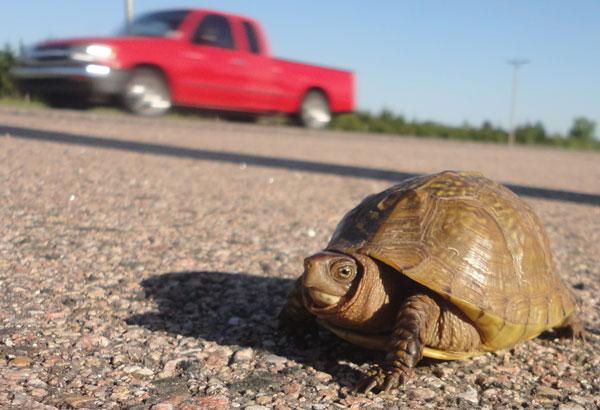
Spring Wildlife
Tuesday, May 3, 2016
Spring has definitely arrived! The trees are green, the nights are warming up and thundershowers have come. With the change of season, wildlife of all sorts are bounding, flourishing, reproducing… and crossing roads! During this time, there are many human-animal interactions and, unfortunately, more unnecessary injuries and deaths. The following are short summaries on how we can initiate a positive outcome for common human-animal interactions.
“Orphan” Wildlife
There are about as many different ways to raise offspring as there are species in the world. Each animal has its own way of doing things.
This is very evident when a baby rabbit or fawn is seen with no parents in sight. Rabbits and deer are both prey species, meaning many animals feed on them, especially the offspring. In order to avoid predator detection, mothers of these species hide their babies and only visit one to two times a day to nurse.
If one is found, leave it alone! The mother will return when she feels it is safe. If you must move them for protection from a dog, lawn-mower or other hazard, place them in another secure location nearby. Better yet, leave the dog on a leash, or don’t mow the grass in that area until the animals leave.
It is a myth that if a baby has been touched or moved that the mother will neglect it.
Baby Birds
Finding baby birds or a fallen nest is a very common wildlife interaction, especially after a storm. In this circumstance, remember that mother knows best. If possible, return the baby birds to the nest.
Alternatively, a nest can be made by placing a small cardboard box in a nearby tree or bush. The mother will find them.
If the bird looks young, but has a full covering of feathers, it is likely a fledgling just learning to fly. It may jump right back out when placed in its nest. This is normal; the mother is likely nearby and will attend to the fledgling until it can fend for itself.
Road Crossing
Perhaps the most visible wildlife interaction is when animals try to cross the road. In late spring, female turtles will leave the pond and search for places to lay eggs.
It takes a long time to grow up and be a mature, egg-laying turtle, so these animals are especially important to their population. Turtles are also beneficial wetland inhabitants and may indirectly contribute to a strong fish population.
If a rock or piece of mud is in the road, slow down and avoid it as it might be a turtle! Helping a turtle cross the road is always a great idea if you can do so safely. Keep your hands away from the mouth when picking up and carrying it in the direction it was traveling. Never pick a turtle up by the tail, as it can cause injury.
With the spring rains, hoards of amphibians may be seen crossing roads from overwintering habitats to breeding wetlands. It is important to drive slowly and carefully when driving past a wetland or habitat that looks to be home to wildlife.
Snakes Aren’t So Bad
After a winter slumber, snakes have emerged to forage for food and go about their business. The majority of snakes in Oklahoma are inoffensive and non-venomous. However, there are a couple of snakes that are of medical significance, so don’t handle a snake unless you have identified it.
All snakes in Oklahoma prefer to be hidden and to not come in contact with people. They are all important members of the food chain and maintain rodent and small animal populations, which has been shown to reduce tick numbers as well.
On the other hand, snakes are an important food source for such charismatic animals as owls, kestrels, fox and mink. If you come across a snake in the wild, simply leave it alone and you will likely never see it again.
If you have any questions or see an animal in need, please call the OSU Veterinary Medical Hospital at 405-744-7000, extension 1. Someone from the Avian, Exotics and Zoological Service will be happy to assist. The AEZ service took in more than 300 wildlife patients in 2015.
by Ian Kanda, RVT
Veterinary Viewpoints is provided by the faculty of the OSU Veterinary Medical Hospital. Certified by the American Animal Hospital Association, the hospital is open to the public providing routine and specialized care for all species and 24-hour emergency care, 365 days a year.
